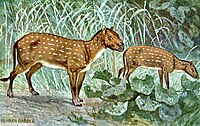User:Abyssal/Portal:Paleogene
IntroductionThe Paleogene Period (IPA: /ˈpeɪli.ədʒiːn, -li.oʊ-, ˈpæli-/ PAY-lee-ə-jeen, -lee-oh-, PAL-ee-; also spelled Palaeogene or Palæogene) is a geologic period and system that spans 43 million years from the end of the Cretaceous Period 66 million years ago (Mya) to the beginning of the Neogene Period 23.03 Mya. It is the first part of the Cenozoic Era of the present Phanerozoic Eon. The earlier term Tertiary Period was used to define the time now covered by the Paleogene Period and subsequent Neogene Period; despite no longer being recognized as a formal stratigraphic term, "Tertiary" still sometimes remains in informal use. Paleogene is often abbreviated "Pg", although the United States Geological Survey uses the abbreviation "Pe" for the Paleogene on the Survey's geologic maps. During the Paleogene period, mammals continued to diversify from relatively small, simple forms into a large group of diverse animals in the wake of the Cretaceous–Paleogene extinction event that ended the preceding Cretaceous Period. (Full article...) Selected article on the Paleogene world and its legacies The Archaea show many differences in their biochemistry from other forms of life, and so they are now classified as a separate domain in the three-domain system. So far, the Archaea have been further divided into four recognized phyla. Classification is still difficult, because the vast majority have never been studied in the laboratory. Archaea and bacteria are quite similar in size and shape, but despite this visual similarity to bacteria, archaea possess genes and several metabolic pathways that are more closely related to those of eukaryotes. Other aspects of archaean biochemistry are unique, such as their reliance on ether lipids in their cell membranes. Archaea use a much greater variety of sources of energy than eukaryotes: ranging from familiar organic compounds such as sugars, to ammonia, metal ions or even hydrogen gas. Salt-tolerant archaea use sunlight as an energy source, and other species of archaea fix carbon. Archaea reproduce asexually by binary fission, fragmentation, or budding. Archaea are found in a broad range of habitats, includingsoils, oceans, marshlands and the human colon and navel. Archaea are now recognized as a major part of Earth's life and may play roles in both the carbon cycle and the nitrogen cycle. (see more...) Did you know?
Need help?Do you have a question about Abyssal/Portal:Paleogene that you can't find the answer to? Consider asking it at the Wikipedia reference desk. Selected image
Selected article on the Paleogene in human science, culture and economicsThe Bone Wars is the name given to a period of intense fossil speculation and discovery during the Gilded Age of American history, marked by a heated rivalry between Edward Drinker Cope and Othniel Charles Marsh. The two paleontologists used underhanded methods to out-compete the other in the field, resorting to bribery, theft, and destruction of bones. The scientists also attacked each other in scientific publications, attempting to ruin the other's credibility and cut off his funding. Originally colleagues who were civil to each other, Cope and Marsh became bitter enemies after several personal slights between them. Their pursuit of bones led them west to rich bone beds in Colorado, Nebraska, and Wyoming. From 1877 to 1892, both paleontologists used their wealth and influence to finance their own expeditions and to procure services and fossils from dinosaur hunters. By the end of the Bone Wars, both men exhausted their funds in fueling their intense rivalry. Cope and Marsh were financially and socially ruined by their efforts to disgrace each other, but their contributions to science and the field of paleontology were massive; the scientists left behind tons of unopened boxes of fossils on their deaths. The feud between the two men led to over 142 new species of dinosaurs being discovered and described. Several historical books and fictional adaptations have also been published about this period of intense paleontological activity. (see more...) TopicsGeochronology - Paleogene (Paleocene - Eocene - Oligocene) Paleogene landmasses - Major Paleogene events - Paleogene biota appearances - Fossil sites - Stratigraphic units - History - History of paleontology - Timeline of paleontology Researchers - Culture - Treatise on Invertebrate Paleontology - Vertebrate Paleontology SubcategoriesQuality ContentThings you can doRelated contentAssociated WikimediaThe following Wikimedia Foundation sister projects provide more on this subject:
|




















